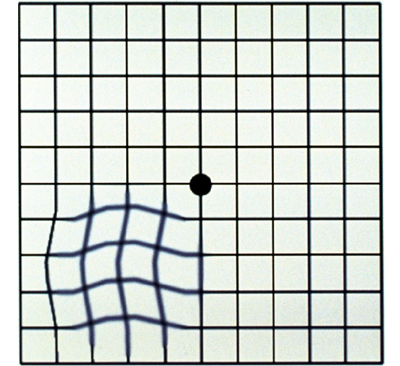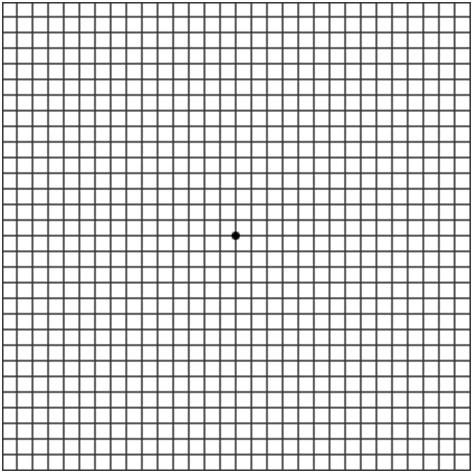What is Macular Degeneration?
Macular degeneration is a deterioration or breakdown of the macula. The macula is a small area in the retina at the back of the eye that allows you to see fine details clearly and perform activities such as reading and driving. When the macula doesn’t function correctly, your central vision can be affected by blurriness, dark areas or distortion. Macular degeneration affects your ability to see near and far, and can make some activities – like threading a needle or reading – difficult or impossible.
Although macular degeneration reduces vision in the central part of the retina, it doesn’t affect the eye’s side or peripheral vision. For example, you could see the outline of a clock, but not be able to tell what time it is.
Macular degeneration alone does not result in total blindness. Even in more advanced cases, people continue to have some useful vision and are often able to take care of themselves. In many cases, muscular degeneration’s impact on your vision can be minimal.

What Causes Macular Degeneration?
Many older people develop macular degeneration as part of the body’s natural aging process. There are different kinds of macular problems, but the most common is age-related macular degeneration. Exactly why it develop is not known, and no treatment has been uniformly effective. Macular degeneration is the leading cause of severe vision loss in people over 65.
The two most common types of age-related degeneration are “dry” (atrophic) and “wet” (exudative):
“Dry” Macular Degeneration (Atrophic)
Most people have the “dry” form of macular degeneration. It is caused by aging and thinning of the tissues of the macula. Vision loss is usually gradual.
“Wet” Macular Degeneration (Exudative)
The “wet” form of macular degeneration accounts for about 10% of all macular degeneration cases. It results when abnormal blood vessels form underneath the retina and the back of the eye. These new blood vessels leak fluid or blood and blur central vision. Vision loss may be rapid and severe.
What are the Symptoms of Macular Degeneration?
Macular degeneration can cause different symptoms in different people. The condition may be hardly noticeable in its early stages. Sometimes only one eye loses vision while the other eye continues to see well for many years.
But when both eyes are affected, the loss of central vision may be noticed more quickly. Following are some common ways vision loss is detected:
- Word on a page look blurred
- A dark or empty area appears in the center of vision
- Straight lines look distorted as in the following diagram
How is Macular Degeneration Diagnosed?
Many people do not realize that they have a macular problem until blurred vision becomes obvious. Your ophthalmologist can detect early stages of macular degeneration during a medical eye examination that includes the following:
A simple vision test in which you look at a chart that resembles graph paper (Amsler grid)
Viewing the macula with a special instrument
Sometimes special photographs and scans of the eye are taken to find abnormal blood vessel s under the retina.
How is Macular Degeneration Treated?
Despite ongoing medical research, there is no cure yet for “dry” macular degeneration. Some doctors believe that nutritional supplements may slow macular degeneration, although this has not yet been proven. Treatment of this condition focuses on helping a person find ways to cope with visual impairment.
Laser Surgery and Intra-ocular Injection Therapy
Certain types of “wet” macular degeneration can be treated with laser surgery or intra-ocular injection therapy, a brief and usually painless outpatient procedure. The procedures may preserve more sight overall, though it is not a cure that restores vision to normal.
Despite advanced medical treatment, many people with macular degeneration still experience some vision loss.
To help you adapt to lower vision levels, your ophthalmologist can prescribe optical devices or refer you to a low-vision specialist or center. A wide range of support services and rehabilitation programs are also available to help people with macular degeneration maintain a satisfying lifestyle.
Because side vision is usually not affected, a person’s remaining sight is very useful. Often, people can continue with many of their favorite activities by using low-vision optical devices such as magnifying devices, closed-circuit television, large-print reading materials, and talking or computerized devices.
Testing Your Vision with the Amsler Grid
You can check your vision daily by using an Amsler grid like the one pictured below. You may find changes in your vision that you wouldn’t notice otherwise. Putting the grid on the front of your refrigerator is a good way to remember to look at it each day. Click on the image to get a page with just the image for printing.
To use the grid:
- Wear your reading glasses and hold this grid 12-15 inches away from your face in good light.
- Cover one eye.
- Look directly at the center dot with the uncovered eye.
- While looking directly at the center dot, note whether all lines of the grid are straight or if any areas are distorted, blurred, or dark.
- Repeat the procedure with the other eye.
- If any area of the grid looks wavy, blurred or dark, contact your ophthalmologist immediately.
Read More
Learn about the Doctors that can treat your floaters and flashes
Read about other eye problems
Understand Cataract Surgery







